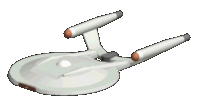The Thofsin class battlecruiser was 360 meters long and had a standard crew complement of 86. The ship was heavily armed, featuring particle cannons, but it lacked torpedo launchers. In total some 415 ships of this class were built.
The hull was made of duranium alloy. The deflector shields were strong for ships of the era, but the hull was weaker and particularly vulnerable when the shields were down because it lacked hull plating that could be polarized.
Because prior to the advent of the Federation, the Andorian empire was on the brink of war with the Tellarites and Vulcans, the battlecruiser was designed for war as part of a strategy of deterrence.
The Thofsin class was the equivalent of the Vulcan D’Kyr class warship. Five particle cannon emitters were positioned on the fore, port, starboard, ventral and dorsal hulls. Each of the emitters had a 180 degree firing arc. The cannons could be fired as continuous beams and projectile-like bursts.
The main bridge was crewed by five officers. The commanding officer sat in a command chair. The officer’s stations were visible to the commander, this highly efficient bridge design was mirrored in new designs after the founding of Federation Starfleet.
The hull consisted of an engineering section with two weapon/engine pods mounted on wing-like pylon structures. Shuttle and cargo bays were housed in the central hull. A The forward hull section housed crew areas and the main bridge.
The Kumari was one of the most notable members of this class, under Commander Thy’lek Shran.
Design from Star Trek Enterprise, Class name and some details from FASA.








You must be logged in to post a comment.